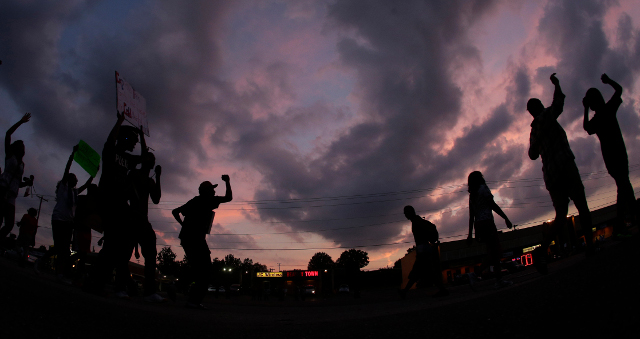
In this Aug. 18, 2014 photo taken with a fisheye lens, people protest for Michael Brown who was killed by police Aug. 9 in Ferguson, Mo. (AP Photo/Charlie Riedel, File)
Ferguson, Missouri, was a powder-keg waiting for a match long before August 9 and Michael Brown’s fateful encounter with Police Officer Darren Wilson. It is one of many predominantly black communities across the United States plagued by highly concentrated poverty, and all of the social problems that accompany it.
White America has come up with a number of rationales for these enduring pockets of despair. An elaborate mythology has developed that blames it on a “culture of poverty” — holding the poor culpable for their poverty and letting our political and economic systems off the hook. A somewhat more enlightened view holds that whites simply fled areas like Ferguson — which had a population that was 99 percent white as recently as 1970 — because of personal racial animus, leaving them as hollowed-out, predominantly black “ghettos.”
But a study by Richard Rothstein, a research fellow at the Economic Policy Institute, comes to a very different conclusion. In his report, “The Making of Ferguson,” Rothstein details how throughout the last century a series of intentionally discriminatory policies at the local, state and federal levels created the ghettos we see today. BillMoyers.com spoke with Rothstein about the report. The transcript below has been edited for length and clarity.
Joshua Holland: Most people believe that Ferguson became so racially polarized because of “white flight” — white people fled the area because of personal prejudice against African-Americans. In your report, you argue that this misses a crucial point. What are we overlooking?
Rothstein: The segregation that characterizes Ferguson, and that characterizes St. Louis, was the creation of purposeful public policy. We have a segregated nation by design.
The St. Louis metropolitan area was no different from most metropolitan areas of the country. The ghetto in the central city of St. Louis was redeveloped for universities, and for a number of other uses, and the African American population in the central city was shifted to inner ring suburbs like Ferguson.
It was done primarily with two policies: First, public housing was segregated, purposely, by the federal government, so that what were previously somewhat integrated neighborhoods in urban areas were separated into separate black and white public housing projects.
And then, in the 1950s, as suburbs came to be developed, the federal government subsidized white residents of St. Louis to move to the suburbs, but effectively prohibited black residents from doing so. The federal government subsidized the construction of many, many subdivisions by requiring that bank loans for the builders be made on the condition that no homes be sold to blacks.
Because black housing was so restrictive, there were so few places where African-Americans could live in St. Louis. So what was left of St. Louis’ African-American community became overcrowded. City services were not readily available. The city was zoned so that the industrial or commercial areas were placed in black neighborhoods but not in white neighborhoods. So the industrial areas, where African-Americans lived, became slums.
And then white residents in places like Ferguson came to associate slum conditions with African-Americans, not realizing that this was not a characteristic of the people themselves, but rather it was a creation of public policy.
This is a somewhat oversimplified description of a complex array of policies. But every policy that I described in this report can be found in every other metropolitan area throughout the country. These policies applied in the New York City area, and they applied in the liberal San Francisco area. It’s a story that characterizes the entire country, but you cannot understand what’s going on with Ferguson today without knowing this history.
Holland: Who was Adel Allen, and why is his story — which took place in nearby Kirkwood, Missouri — important for understanding how Ferguson came to be the city it is today?
Rothstein: Adel Allen was an African American engineer for the McDonnell Douglas Corporation. He was recruited from Kansas to work in the St. Louis metro area. When he got there, he couldn’t find housing anywhere in the suburban areas near the plant. He was about to move back to Kansas, because the only place he could find housing was in overcrowded conditions in the central St. Louis ghetto.
He finally got a white friend to buy a home for him in the town of Kirkwood. He moved into a block that was overwhelmingly white. There were 30 white families. Seven years later, there were 30 black families and two white families on that block. And this was largely because of practices in the real estate industry.
Those real estate agents then bought those properties at very low prices and resold them to African-Americans, who had to pay very high prices because they had no other housing options.
Now, this was something that was not considered unethical until the 1970s. In fact, licenses would be suspended by the state real estate commission if a real estate agent sold a home to a black family in a white neighborhood — until the first one sold, and then it was considered perfectly ethical for real estate agents to turn an entire block into an African-American block.
Once they moved into that block, all of a sudden, over the course of a few years, city services began to decline. Other parts of Kirkwood which were overwhelmingly white continued to get good services, but the African-American neighborhoods were denied. The rest of the city got sidewalks and curbs; the black blocks did not.
Holland: You also write, “State sponsored labor and employment discrimination reduced the incomes of African-Americans relative to whites in St. Louis.” So as a result, even absent these kinds of housing policies you describe, African-Americans would be hard-pressed to afford to live in a decent white suburb.
Rothstein: That’s right. In St. Louis, African-Americans were excluded from good-paying jobs for most of the 20th century. They opened up only beginning in the 1970s. For example, construction jobs during the enormous housing boom that created the suburbs in the 1940s, ’50s and ’60s were completely closed to African-Americans because they could not be admitted to construction unions, and the federal government certified every one of those segregated unions as the exclusive agent for their trades in those construction sites. So it’s not simply the result of private discrimination by the unions. This was something that was sanctioned by the federal government. It wasn’t until the 1960s that the National Labor Relations Board first withdrew certification from a segregated union and the policy didn’t become widespread for at least another 10 years or so.
There are many other examples I could give you. During the enormous employment boom during World War II, St. Louis was a big center of arms manufacturing. Lots of workers flooded to St. Louis from the Ozarks and other areas, black workers as well as white workers. But the largest ammunition producer would not hire African-Americans until the war was almost over.
So all of those lost opportunities for employment created a situation where African-American incomes were much, much lower than white incomes.
Holland: I’m going to ask you to connect some dots. Many of the things you describe in the paper haven’t been legal for quite a bit of time. How does this legacy of institutional racism in the past set up the unrest that has played out in Ferguson after the shooting death of Michael Brown?
Rothstein: As we know from a lot of recent research, intergenerational income mobility in this country is quite low. If you’re born into a low-income family, the chances are very, very great that you yourself will have a low income. We don’t have nearly the kind of mobility that is mythical in this country.
So after a century of policies which denied African-Americans access to jobs that pay decent wages, the likelihood is that their children and their children’s children will still be paying the price for those policies that held their parents and grandparents behind for so long.
And then there are the housing policies. Let me take the example of the suburb of Kirkwood. In the 1950s, when Kirkwood was being developed, those homes were selling for about $8,000 dollars each, which was about two times the national median income at that time. Working families could afford to buy a home for twice median income, but only whites were permitted to buy into Kirkwood. Any white working family could’ve afforded to buy those homes, and very often, they were further subsidized by the federal government — veterans could buy with no down payment, and obtain loans at very low interest rates.
Those families then benefited from a half-century of equity appreciation in their homes. If they moved, they profited on the sale. And they were able to transmit that equity to their children. Their children were secure. Their children were able to go to college.
Today, those same homes that sold for $8,000 in the 1950s sell for $400,000, which is about six or seven times national median income. So today, working families, whether white or black, can’t afford to buy in Kirkwood. Fifty years ago, when whites similar to them in every other respect except their race were populating the suburbs, African-American families were not permitted to do so, so the legacy of that discrimination continues to this date. Poor African-Americans got crowded into ghettos — into all black, low-income neighborhoods like Ferguson.
And because the Federal Housing Administration refused to guarantee mortgages for African-Americans and would only guarantee mortgages for whites, black people who could afford to buy homes couldn’t get mortgages for them. So speculators sold those homes to them on contract, like on an installment plan. And if they were ever late with a payment, their house would be immediately repossessed and resold again on contract to someone else. In order to be able to make these contract payments, which were very high because the demand for housing was so great relative to the supply available to African-Americans, families doubled up, they subdivided their homes, they rented out parts of their homes. That’s a great example of how public policies led to the formation of slums.
This then became a multigenerational problem.
Download Rothstein’s report, “The Making of Ferguson,” at the Economic Policy Institute or read his article from the Fall 2014 issue of The American Prospect entitled “The Making of Ferguson: How Decades of Hostile Policy Created a Powder Keg.”

This work is licensed under a Creative Commons Attribution-NoDerivatives 4.0 International License.


